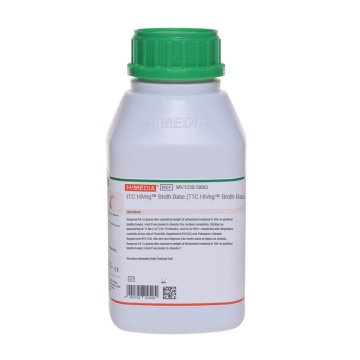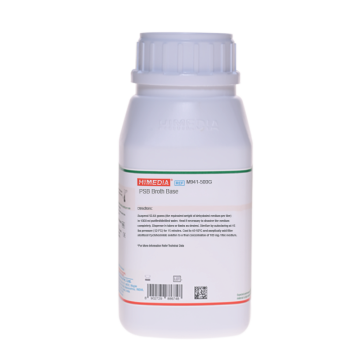 Your enquiry has been submitted
Your enquiry has been submitted
ITC Broth Base (TTC Broth Base)
Enrichment#CC293D
Intended Use
Recommended for selective enrichment and enumeration of Yersinia enterocolitica. The composition and performance criteria of this medium are as per the specifications laid down in ISO 10273:2017 and 11133:2014 (E) /Amd. :2020.
Composition
ISO Specification - Irgasan, ticarcillin and potassium chlorate (ITC) broth
| Ingredients | g/L |
|---|---|
| Enzymatic digest of casein | 10.000 |
| Yeast extract | 1.000 |
| Magnesium chloride hexahydrate | 60.000 |
| Sodium chloride | 5.000 |
| Malachite green | 0.010 |
| Triclosan (Irgasan) | 0.001 |
| Final pH (at 25°C) | 6.9±0.2 |
M1220 - ITC Broth Base (TTC Broth Base)
| Ingredients | g/L |
|---|---|
| Tryptone # | 10.000 |
| Yeast extract | 1.000 |
| Magnesium chloride hexahydrate | 60.000 |
| Sodium chloride | 5.000 |
| Malachite green | 0.010 |
| Triclosan (Irgasan) | 0.001 |
| Final pH (at 25°C) | 6.9±0.2 |
Tic Selective Supplement (FD102)- 1 vial
- Ticarcillin: 1 mg
PC Selective Supplement (FD103) - 1 vial
- Potassium chlorate: 1 g
- Distilled water: 10.00 ml
**Formula adjusted, standardized to suit performance parameters
# Equivalent to Enzymatic digest of casein
Directions
Suspend 44.12 gram (the equivalent weight of dehydrated medium) in 988 ml purified/distilled water. Heat if necessary to dissolve the medium completely. Sterilize by autoclaving at 15 lbs (121°) for 15 minutes. Cool to 45-50°C. Aseptically add rehydrated contents of one vial of Tic Selective Supplement (FD102) and PC Selective Supplement (FD103). Mix well and dispense into sterile tubes or flasks as desired.
Principle And Interpretation
The genus Yersinia belongs to the family Enterobacteriaceae. They are usually nitrate reductase positive and show fermentative metabolism. The genus comprises of 11 species, of which Yersinia enterocolitica is most important as a causative agent of human foodborne illness. Variety of enrichment methods has been described for recovery of Y.enterocolitica from foods. The most efficient procedures for recovering enteropathogenic bacteria from foods have incorporated at least one and often two enrichment steps before plating onto selective differential agar media. ITC Broth is formulated in accordance with APHA (1) and is recommended by ISO Committee (2,3) as a selective enrichment medium for Y.enterocolitica from foods. ITC Broth was developed by Wauters et al (4) as a new enrichment broth, derived from modified Rappaport Broth and based on the selective agents irgasan (ticarcillin) and potassium chlorate.
Tryptone and yeast extract provide nitrogeneous and carbonaceous compounds, long chain amino acids and other essential growth nutrients. Ticarcillin has inhibitory action on both gram-positive and gram-negative organisms. Irgasan inhibits gram-positive organisms. Potassium chlorate has disinfecting properties.
Type of specimen
Food and animal feeding stuff
Specimen Collection and Handling
Processing (1-3)
Enrichment: For the first initial suspension place the sample (x) in known volume of the PSB broth (M9411), to give a dilution of 1/10 dilution (by mass/volume or volume/volume). Homogenize the suspension using a peristaltic blender for 2 min. Incubate at 22°C to 25°C for 2 to 3 days with or 5 days without agitation.
For the second initial suspension in the same way with the ITC broth (M1220) so as to obtain a test portion/enrichment medium dilution of 1/100 (mass/volume or volume/volume). Incubate at 25°C for 48 hours.
Isolation :
- Inoculate the culture obtain from PSB culture on the surface of CIN agar plate and incubate at 30°C for 24 to 48 hours.
- Alkaline treatment : Using sterile pipette transfer 0.5ml of the PSB culture into 4.5 ml of KOH solution and mix for 20 seconds only. Immediately inoculate on CIN agar plate. Incubate at 30°C for 24 to 48 hours.
- Using ITC culture inoculate the surface of CIN agar plate (M843I). Incubate at 30°C for 24 to 48 hours.
Purification: Streak the selected colonies on the surface of Nutrient Agar (M561A). Incubate at 30°C for 24 hours.
Confirmation: Biochemical and serological tests are performed for confirmation.
Warning and Precautions
Read the label before opening the container. Wear protective gloves/protective clothing/eye protection/face protection. Follow good microbiological lab practices while handling specimens and culture. Standard precautions as per established guidelines should be followed while handling specimens. Safety guidelines may be referred in individual safety data sheets.
Performance and Evaluation
Performance of the medium is expected when used as per the direction on the label within the expiry period when stored at recommended temperature.
Quality Control
Appearance Light yellow to light blue homogeneous free flowing powder
Colour and Clarity of prepared medium Peacock green coloured, clear solution without any precipitate
Reaction Reaction of 4.41% w/v aqueous solution at 25°C. pH: 6.9±0.2
pH 6.70-7.10
Cultural Response
Productivity: Cultural characteristics observed with added Tic Supplement (FD102) and PC Supplement (FD103) after an incubation at 25±1°C for 44±4 hours. Recovery is carried out on CIN Agar (M843I) and characteristic reaction noted.
Selectivity: Cultural characteristics observed with added Tic Supplement (FD102) and PC Supplement (FD103) after an incubation at 25±1°C for 44±4 hours. Recovery is carried out on Soyabean Casein Digest Agar (M290).
| Organism | Inoculum (CFU) | Growth | Characteristic reaction of target organism on CIN Agar (M8431) |
|---|---|---|---|
| Productivity | |||
| Yersinia enterocolitica subsp. palearctica serotype O:3 NCTC 13769 (00126)*+ | 50-100 | >10 colonies | Transparent or translucent circular, smooth colonies with deep red sharp bordered centre. |
| Escherichia coli ATCC 25922 (00013*) | >=104 | ||
| Pseudomonas aeruginosa ATCC 27853 (00025*) | >=104 | ||
| Yersinia enterocolitica subsp. palearctica serotype O:3 NCTC 13769 (00126)* + Escherichia coli ATCC 8739 (00012*) + Pseudomonas aeruginosa ATCC 27853 (00025*) | 50-100 | >10 colonies | Transparent or translucent circular, smooth colonies with deep red sharp bordered centre. |
| >=104 | |||
| >=104 | |||
| Yersinia enterocolitica ATCC 23715 (00160)* + Escherichia coli ATCC 25922 (00013*) + Pseudomonas aeruginosa ATCC 27853 (00025*) | 50-100 | >10 colonies | Transparent or translucent circular, smooth colonies with deep red sharp bordered centre. |
| >=104 | |||
| >=104 | |||
| Selectivity | |||
| Pseudomonas aeruginosa ATCC 27853 (00025*) | >=104 | inhibited | |
| Proteus mirabilis ATCC 29906 (00023*) | >=104 | inhibited | |
Storage and Shelf Life
Store between 10-30°C in a tightly closed container and the prepared medium at 2-8°C. Use before expiry date on the label. On opening, product should be properly stored dry, after tightly capping the bottle in order to prevent lump formation due to the hygroscopic nature of the product. Improper storage of the product may lead to lump formation. Store in dry ventilated area protected from extremes of temperature and sources of ignition. Seal the container tightly after use. Product performance is best if used within stated expiry period.
Disposal
User must ensure safe disposal by autoclaving and/or incineration of used or unusable preparations of this product. Follow established laboratory procedures in disposing of infectious materials and material that comes into contact with sample must be decontaminated and disposed of in accordance with current laboratory techniques (5,6).
Reference
- Salfinger Y., and Tortorello M.L., 2015, Compendium of Methods for the Microbiological Examination of Foods, 5th Ed., American Public Health Association, Washington, D.C.
- ISO 10273:2017 Microbiology of the food chain Horizontal method for the detection of pathogenic Yersinia enterocolitica
- Microbiology of food,animal feeding stuffs and water- Preparation, production,storage and performance testing of culture media, EN ISO 11133:2014 (E) /Amd.2 :2020.
- Wauters G., Goossens V., Janssens M. and Vandepitte J., 1988, In. J. Syst. Bacteriol., 38, 424-429.
- Isenberg, H.D. Clinical Microbiology Procedures Handbook 2nd Edition.
- Jorgensen, J.H., Pfaller, M.A., Carroll, K.C., Funke, G., Landry, M.L., Richter, S.S and Warnock., D.W. (2015) Manual of Clinical Microbiology, 11th Edition. Vol. 1.
| Product Name | ITC Broth Base (TTC Broth Base) |
|---|---|
| SKU | M1220 |
| Product Type | Regular |
| Physical Form | Powder |
| Origin | Animal |
| Packaging type | HDPE |
| References | 1. American Public Health Association, Standard Methods for the Examination of Dairy Products, 1978, 14th Ed., WashingtonD.C. |
| Customized Product Available | No |










